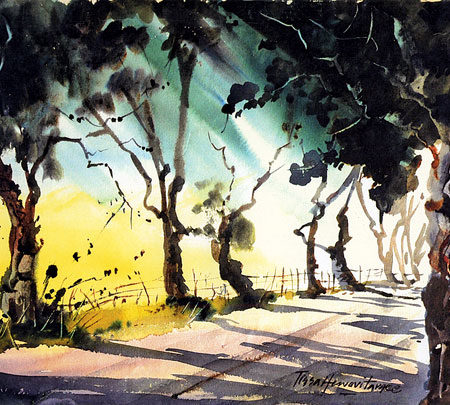|
Painting 101:
Painting trees and sky and clouds
by Tissa Hewavitharana
The difference between a photograph and a painting is that, a
painting expresses more than just the surface appearance of things with
each stroke of the brush, the artist expresses his or her own
personality and feelings about the subject.
 |
|
Shady Trees |
This applies particularly in a water colour painting, in which every
brush mark remains visible and therefore becomes an integral part of the
finished image. Beginners, through, have a tendency to be rigid and
flexible in their brush work because they lack the confidence to be able
to let go and adapt to the spontaneous qualities of water colour.
Don't be a slave to your subject break loose from it and let your
enjoyment of it come through in your painting. Remember you don't have
to paint a mater piece every time. Sometimes it's good simply to
experiment and discover new ways of manipulating the brush and the
paint.
Trees can have many shapes, but they are easily represented with a
simple combination of shadowing.
A water colour must always be painted from light to dark. After
outlining the area where the trees must go, a light green wash is
applied, and then the contrasts are put in.
Expressive brush strokes
Various effects can be achieved with a dry brush. A day brush stroke
on a dry back ground brings out the grain of the paper and can create an
interplay with previously applied coats of paint. A dry brush can be
used to paint over a white surface or one previously tinted with a wash.
The technique of using a dry brush is one of the most interesting
ones that can be performed with water colour.
Naturally it isn't something to be used at all times since some areas
of a painting will inevitably demands techniques involving blending
colours or creating gradations.
Landscape
Take the landscape painting I have titled 'Shady Trees". The exercise
that follows is a landscape with a group of trees in the foreground. The
greens in this landscape are fresh and vibrant because the artist has
built up his colours and tones with lively strokes of dark green, blue
and yellow.
This painting is sufficiently' rich in shades and textures to allow
it to perfectly demonstrate the technique of using the dry brush.
The tree trunks are precisely sketched and its most twisted branches
are clearly shown. Instead of trying to paint individual leaves I have
used small flecks and dabs of paint which indicate clusters of foliage
without appearing stilted.
Trees are three-dimensional not flat, as they are so often portrayed.
Notice the trees and foliage are massed into groups of light and dark
tone so that each one registers strongly against the other.
Warm and cool greens built up with transparent glazes give the effect
of sun shining through leaves. Finally, when all the paint is dry, the
tall trees in the foreground (on the left) is added... Soft flowing
brush strokes are made at an inclined angle to race the stalks.
The brush should not be too loaded with paint to allow broken brush
strokes.
The landscape here shows that the shadows are a marvellous device for
conveying an impression of bright sunshine. Here the pattern on shadows
cast by the trees activates the composition and creates a buoyant spring
- like feel.
The area corresponding to the road, is minimally but clearly
outlined. Care is taken to give a light yellow ochre wash that
differentiates the road from it vegetation. A light purple mixture is
used to show the shadows fallen on the road. Shadows can be used to help
build up or strength a composition.
Middle and dark values
This pattern of values is well suited for landscape painting. The
sky, the source of light is very light in value. All horizontal planes,
since they are perpendicular to the source of light, are also very light
in value. All planes that are parallel to the light source do not
receive the full intensity of the light source and are middle values and
dark values. So a typical landscape scene is middle values and dark
values against light values. This is a generalisation and should be
taken as such.
The technique of using a dry is one of the most interesting ones that
can be performed with watercolour. Naturally, it isn't something to be
used at all times, since some areas of a painting will inevitably demand
techniques involving blending colours or creating gradations.
Sky and clouds
When painting the sky, it should be planned beforehand what sort of
weather conditions you are going to have, whether it's windy, sunny day
with a lot of white clouds, or an approaching storm or a rainy day, or
even clear blue sky. Even clear blue sky should graduate in tone with
the colour at the horizon being weaker.
Combining techniques
The special techniques do not have to be used constantly in
watercolours. In general, it is better to use these effects as very
defining notes in any work. All the techniques of water colour must be
combined intelligently so that the painting is not cluttered up with
special effects. When composing a sunny scene, remember that either the
bright warm areas should dominate or the cool, dark shadow areas. If
there is an even spread of light and dark, the effects of bright
sunshine will be lost. The painting related to this article demonstrates
how successful, when painting a bathed in bright sunshine is much
exciting and vibrant.
www.tissahewavitarane.com |

